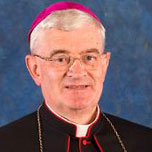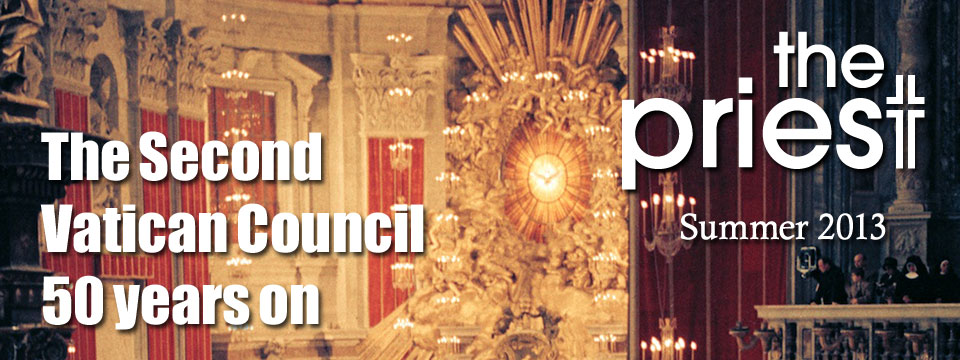The new Missal translation is like rediscovering buried treasure
Many Catholics who regularly go to Mass seem to be unaware that the texts we use to worship God have been translated from Latin. For over 40 years, ever since the new rite of Mass (Novus Ordo) was introduced after the Second Vatican Council, we have used a translation prepared by the International Commission for English in the Liturgy (ICEL). This year, a new English translation of the 2002 Latin edition of the Missale Romanum, the Roman Missal, will be introduced. Anew Lectionary will follow, no longer derived from the Jerusalem Bible. In the next few years, all the sacramental rites will appear in a new translation. But the first project is the missal. A reorganised ICEL has worked on the translations, under the guidance of the Congregation for Divine Worship and the Sacraments through the Vox Clara (“A Clear Voice”) committee, chaired by Cardinal George Pell.
The new principles for translation are set out in an official instruction Liturgiam authenticam. The drafts of new texts have been carefully prepared, revised and corrected over the past nine years. All the Bishops in countries where English is used in worship have been consulted. They have been able to invite experts to comment and advise them. Finally, each Conference of English speaking Bishops has voted on the final drafts, in “the grey books”, and the agreed text of the missal has already been presented to the Holy Father, who warmly welcomed it. The printing of new missals for the altar and the people is under way, a massive project as there is one version for the whole English speaking world. Other language groups are under notice that they too must review and re-translate their texts, in particular the liturgy in French and German which is replete with inaccuracies. Not only in the English speaking world have people been grumbling about shoddy translations from the past and seeking something better.
The reason for the new translation
But do we need a new translation of the Mass in English? Is the text we currently use not good enough? No, it is not good enough because it is not particularly good – and “good enough” is not the way to describe the language we should use in the worship of God. The time has come to change because what we are using is not only often inaccurate as a translation, but the style of English is rather dull, banal, lacking in the dignity of language for worship, more like the language of a homily than a prayer.
How did this come about? To be fair, it needs to be stated at the outset that this dismal situation was brought about by good pastoral and catechetical intentions. The Bishops in the early seventies were anxious to get the “new missal” to the people in the translation, and what they hastily approved was distorted because it was based on a flawed principle of translation known as “dynamic equivalence”. The principle was endorsed in the 1969 instruction of the Consilium for Implementing the Constitution on the Sacred Liturgy, Comme le prevoit. {{1}} ICEL was faithful to much of that instruction, and even went beyond it, so what we ended up with was a paraphrase rather than a translation.
Dynamic equivalence demands a lively, modern translation that is supposed to get to the meaning of the Latin without literally translating every word. That method can be useful in on-the-spot translation from a modern language by an interpreter who knows the familiar idioms. I have used it myself while working at meetings in the Vatican. But paraphrasing is not good enough for sacred texts composed in Latin and Greek over many centuries for use in Divine Liturgy. A paraphrase can fail to give us, not only what the Latin original means, which is bordering on telling lies, but paraphrase often eliminates poetic beauty in the original, particularly scriptural language that runs through the prayers of the Roman Rite of Mass. I will take some Sunday collects as an example of a “not good enough” translation.
Comparing Collects
Thirty five years ago an Australian Archbishop involved in ICEL told me that a religious, un-named, had translated the Sunday collects (Prayers of the Assembly) in use today. He praised this work. When I groaned, he scowled and changed the topic. (You can see that I have disliked the translations for many years!) But the collects surely rank among the worst instances of liturgical translation. They are as brief as their Latin originals, but that is not what a vernacular version of a collect should be, for the compact Latin of a collect is a literary genre with its own conventions and structure, demanding rich expansion once you put it into the vernacular, otherwise it sounds abrupt, trite, even absurd, which is what happened.
Each collect was reduced to something like this: “God! You are good. So do this for us”, followed by a slightly inaccurate version of the Trinitarian ending. Yet, by eliminating any traces of the Latin oratorical cursus, a rhetorical prose cadence, the unknown translator had only followed the flawed principle of dynamic equivalence in Comme le prevoit. {{2}}
Let us take the Collect for the Eighteenth Sunday in Ordinary Time, and then compare it to the new version. First listen to the version we currently use, which is quite a good prayer:
Father of everlasting goodness,
our origin and guide, be close to us
and hear the prayers of all who praise you
Forgive our sins and restore us to life.
Keep us safe in your love.
We ask this through our Lord Jesus Christ your Son,
who lives and reigns with you and the Holy Spirit,
one God, for ever and ever. Amen.
Now listen to what we will pray in the new translation:
Draw near to your servants, O Lord,
and never cease to welcome their prayers,
that, for those who glory in you as Creator and guide,
you will restore what you have created
and keep safe what you have restored.
Through our Lord Jesus Christ your Son,
who lives and reigns with you, in the unity
of the Holy Spirit, God for ever and ever. Amen.
You can hear the difference. The first prayer was broken up into small sentences, with ideas that contrast with one another, while the second flows with continuity and a unity of meaning that is found in the Latin original. There is nothing in the Latin about asking for forgiveness of sins. Rather, the emphasis is on God’s grace restoring those who recognise their Creator and guide, that is, people with faith.
Questions of doctrinal content also emerge here – and this is a serious matter because it raises the ethical question of telling lies and distorting Catholic truth. When we examine the specific content of the ICEL collects we currently use we find a more serious result of ruthless paraphrase and precis – the virtual elimination of a key Christian word, “grace”. It could be argued that this went beyond Comme le prevoit.
This serious falsification may be observed in the current translations of seven Sunday collects in so-called “Ordinary Time” that contain “gratia”. {{3}} Of these seven collects, not one has translated gratia as “grace”! Gratia is usually rendered as “love”, or “gifts of love” (Sunday XXVI). Surely that is stretching the translation principle of “dynamic equivalence” beyond the limits. For Sunday XXVIII, the beautiful collect about God’s “prevenient grace”, the grace that goes before us, has been hacked to pieces. The word “grace” has been excised and the meaning of the collect has been lost. Likewise, “grace” has effectively vanished in the translations of the Prayer over the Gifts and the Post Communion Prayers. {{4}}
Taking the essential Christian word “grace” out of the key seasonal prayers is a symptom of the deeper doctrinal weakness that is evident in not a few of the current ICEL texts. As others have noted, this is a kind of Pelagianism, the heresy that we save ourselves by our own efforts, not through the grace of God. What we do is what matters, not so much what God does. This led to the mentality that “we make the liturgy” so liturgy is no longer primarily a gift to us from God through the Church; rather, something we fabricate, our work, what we “create”.
Our Lady
Striking examples of inaccuracy are evident if Latin references to Our Lady in the Missale Romanum are checked against the current ICEL texts. Here, we find an amazing failure to comprehend a basic principle of Christology and Mariology. The Marian adjectives are doctrinal, not poetic. All this is corrected in the new translation, which gives full honour to the Mother of God. However, in the current ICEL version, the bland expression “the Virgin Mary” is used again and again. This does not truthfully translate a variety of references to Mary in the Missale Romanum. Nor does “blessed” truly render beatissima, because this superlative, “most blessed”, is reserved for the Mother of God, proclaiming her as the pre-eminent saint, the Queen of all Saints. But, again, this was in line with a specific reference in Comme le prevoit concerning beatissima Virgo or beata et gloriosa, followed by a curious comment: “Understatement in English is sometimes the more effective means of emphasis”. {{5}} Really? The authors of that instruction were blissfully unaware of the Mariological nuances not only of beatissima but, in terms of the Assumption, of beata et gloriosa, “blessed and glorious”. So these Marian adjectives had to be “understated”? “Dynamic equivalence” becomes more destructive when Marian phrases which convey doctrinal truths taught by the Church are simply removed.
In the first Preface of Our Lady, two unequivocal Latin phrases expressing Mary’s perpetual virginity just vanished. The second became a paraphrase “She became the virgin mother of your Son” but that does not carry the Latin virginitatis gloria permanente, literally “the glory of her virginity remaining”. “She became the virgin mother of your Son” barely hints at Mary’s perpetual virginity as set out in the Catechism of the Catholic Church. Here, we touch on trendy ideological motives reflecting the era when the ICEL translations were made. One senses the hand of a translator or committee working away 40 years ago and not wanting to offend someone.
But who was this “someone”? Was this an imaginary, non-Catholic Christian, to be respected out of misplaced ecumenism? But the only groups beyond the Catholic Church who might ever use a Marian Preface would be some high Church Anglicans and Lutherans, and they would be among the first to point out the defects in style and regret devious paraphrases. The more recent ICEL translation of the beautiful new Preface of Mary Mother of the Church is another example of a kind of protective censorship. A reference to Mary’s immaculate heart has been excised. Why? Do the Catholic people need to be protected from “something”? Is it exotic language, or does that phrase hint too much of Fatima? In the collect for the third day before Christmas, the adjective “immaculate” also vanished. In the collect for the Memorial of Our Lady of Mount Carmel, the mystical representation of the Son of Mary as a holy mountain has also vanished, even if it is central to Carmelite spirituality. {{6}} Why?
These examples of the destructive effects of the old ICEL following “dynamic equivalence” reveal a vernacular version of the text of the Roman liturgy that in some places tells lies, so that, at these points and many others, it is no longer authentically the Roman liturgy.
The loss of poetic metaphors
Archbishop Coleridge of Canberra and Goulburn rightly has said that, in the current ICEL texts, the metaphors have been “bleached out”. An obvious one is in the Third Eucharistic Prayer “so that from east to west a perfect offering may be made to the glory of your name.” In Australia, “from east to west” can mean from Sydney to Perth. In the USA, that would be from New York to Los Angeles. But if we go back to the prophecy of Malachi concerning the universal sacrifice, we find poetic language bringing together both space and time. So the new accurate translation from Latin will be: “… so that from the rising of the sun to its setting a pure sacrifice may be offered to your name.” This recaptures the original scriptural text.
In the Latin original of the Second Eucharistic Prayer, the invocation of the Holy Spirit (the epiklesis) carries two beautiful metaphors of God the Father and the Holy Spirit. Currently, this reads: “Lord, you are holy indeed, the fountain of all holiness. Let your Spirit come upon these gifts to make them holy, so that they may become for us the body and blood of our Lord, Jesus Christ”.
The new translation is more precise: “You are indeed holy, O Lord, the fount of all holiness. Make holy, therefore, these gifts, we pray, by sending down your Spirit upon them like the dewfall, so that they may become for us the Body and Blood of our Lord, Jesus Christ.” The new text clarifies the first water metaphor because “fount” means “source”, not a garden fountain. Then it restores the second subtle and poetic water metaphor about the dew. Of course, the new text is slightly longer and the commas will need to be taken into account when it is said aloud. But why rush? Smooth and plain paraphrases take less time to say, but is worship about saving time?
The truth of the mystery
Another dimension of truth in translation is asking whether a text maintains the mystery or a “sense of the sacred” in the original tongue. In the East, mystery in worship is maintained largely by the ikonostasis, the icon screen across the sanctuary. In the West, the Latin language functioned as a kind of ikonostasis of language. Coupled with the celebration of Mass ad orientem, facing the altar, the Roman Rite retained the sense of a holy mystery which the East maintained through the universal liturgical paradox of concealing so as to reveal. {{7}} The truth of the mystery came to be carried in the Latin texts. It is possible to translate the Mass into our vernacular while retaining much of that sense of linguistic mystery, as may already be seen in the work of the current project. The new ICEL translation seeks to reclaim the truth of the mystery. But that was not the prevailing mentality of the era of the sixties. The reasons for this attitude may be discerned by beginning with the obvious “didacticism” of the translations, that is regarding liturgical texts as primarily messages directed at us, to teach us. The didacticism of the current ICEL texts embodies a stage in history when communication was the key to everything – the Sixties, the era of Marshall McLuhan and the “global village”, when “mankind” reached for the stars and we could hear men talking from the moon.
Clarity, comprehensibility, access to data and information, the triumph of the Enlightenment, was also marked by the jostling of ideologies, each claiming to carry the light and future, whether of “modern man”, “secular man” or “socialist man”, to use the language of the pre-feminist vocabulary of those times. In such a social, historical and political context, everything in the [then] new Missale Romanum had to be translated so as to be, above all, comprehensible.
There is little place for mystery in being modern and enlightened because mystery eludes human control, and modern, enlightened people have to be in control. But Pope Benedict XVI, as Cardinal Ratzinger, pointed out that: “The liturgy derives its greatness from what it is, not from what we make of it.” {{8}} In itself, the liturgy finds its “summit and source” in the Eucharist; that is, the sacred Mystery of Faith ever stretching out beyond our control, ever inviting us into deeper union with God. However, the earlier ICEL translations reflected the principle of “dynamic equivalence” in Comme le prevoit. Paraphrases came to bear a modernity that communicated a meaning instantly, in the language of common usage. {{9}} I would call this immediate, accessible meaning. If I translate gratia as “love”, listeners immediately comprehend something, the word “love”. But, in contemporary society, “love” is a polyvalent term; that is, it carries many meanings. Therefore, when the faithful hear “love”, they will not comprehend or retain much of the real meanings of gratia, another polyvalent word but one suggesting a specific range of divine and human realities.
Eucharistic mystery
Liturgiom authenticom and guidance from Vox Clara have freed us from that obsession with instant comprehension, or immediate, accessible meaning which destroyed real meaning. The new ICEL translations reflect not only accuracy but reverence for the mystery of God, indeed the centrality of God, which is the meaning of Christian worship.
To elucidate this, we may compare the two translations of the opening words of the First Eucharistic Prayer, the Roman Canon. The ICEL text that we currently use begins: “We come to you, Father, with praise and thanksgiving through Jesus Christ your Son. Through Him we ask you to accept and bless these gifts we offer you in sacrifice.” By contrast, the new ICEL text begins: “To you, therefore, most merciful Father, we make humble prayer and petition through Jesus Christ, your Son our Lord: that you accept and bless these gifts, these offerings, these holy and unblemished sacrifices …” The old text is smooth, shorter, with good words, but they have nothing to do with the Latin original, the majestic Te igitur clementissime Pater of the venerable Canon. There, the emphasis is on God and how the divine actio liturgica, liturgical action, flows out of the Sanctus and Preface, hence the Te igitur, now recaptured in English as “therefore”. Notice how the new version captures the spiritual sense of reserve and humility before God that characterises the great liturgies of the West and East. The words of consecration are slightly different, particularly the consecration of the wine: “…. For this is the Chalice of my Blood, the Blood of the new and eternal Covenant which will be poured out for you and for many for the forgiveness of sins.” The blood of Christ “will be poured out”, effundetur, and “for many”, pro multis, a particularly delicate change mandated by the Pope to resolve a divisive controversy, raised by some adherents to the 1970 form, but really caused in the first place by the mistranslation. Indeed in respect of the earlier “for all”, it is so that Christ died for all. But his one Sacrifice in the Mass [following the New Testament scriptural words] is applied to “many”.
In the Roman Canon, after the consecration we find a rhythmic repetition: hostiam puram, hostiam sanctam, hostiam immaculatam, now to be rendered as “this pure victim, this holy victim, this spotless victim”. At present this is boiled down as “this holy and perfect sacrifice”. The ICEL of the past avoided repetitions, but repetition is always a part of prayer. The old ICEL airbrushed out that strong sacrificial word “victim”, hostia. The words that follow, explain who “this victim” is, “the holy Bread of eternal life and the Chalice of everlasting salvation”. As at the consecration, we note the recovery of the dignified and accurate term “chalice”, with its religious and cultural connotations. We do not usually ask for “a cup of wine”.
The words of the people
Obviously priests will have to become accustomed to a new style in virtually every prayer they say. But to what extent will the words said by the people be different? Here, care has been taken to keep the changes to a minimum. I indicate what is new at some key points of the Mass.
The first obvious change will be the response to “The Lord be with you”, which will be “And with your spirit”. This brings us into line with all the other major languages where et cum spiritu tuo is translated literally, for example con il tuo spirito in Italian. This is an ancient mystical response to a blessing-greeting, referring either to the priest’s angelic guardian or the presence of the Holy Spirit in the priest or, as is more likely, the spirit within each us. This is why this blessing-greeting with its response is only given by the ordained and not by lay people, for example when a lay person leads a “Communion service”.
In the “I confess” we will admit that we have “greatly” sinned, “through my fault, my own fault, my own most grievous fault”. Again the new ICEL is not afraid of symbolic repetition and respects Catholic familiarity with the mea culpa.
The new text of the Gloria largely returns to the first English translation that was used between 1964 and late 1969. It will be easier to set to music, as we already see in new musical settings that are appearing for the new texts.
In “Pray brothers and sisters. ..”we return to the Latin “my sacrifice and yours”, to restore the distinction between the two modes of offering Mass, that of the priest and that of the priestly people with him. The word “holy” has been restored to the response to qualify “Church”. One wonders why someone presumed to remove one of the four marks of the Church forty years ago. The Church is “one, holy, Catholic and apostolic”.
The only change in the “Holy, holy …” is replacing “God of power and might” with a more literal “Lord God of hosts”, Dominus Deus Sabaoth, the word Sabaoth being a Hebrew reference to the countless angelic armies, in the context of worship. This is a return to the first English version of the Sanctus in the Sixties.
A particularly beautiful development is the complete re-translation of the invitation to Communion. Instead of the blunt and bland “This is the Lamb of God … happy are those who are called to his supper”, the priest will say, “Behold the Lamb of God. Behold him who takes away the sins of the world. Blessed are those called to the supper of the Lamb.” Our response will be closer to the words of the centurion in the Scriptures (Luke 7: 6-7): “Lord, I am not worthy thatyou should enter under my roof, but only say the word and my soul shall be healed.” Note the shift to God’s initiative – not “that I should receive you”; rather “that you should enter under my roof ” and the restoration of “soul”.
Enriching the Mass
There was a fear of the word “soul” among theologians forty years ago. Since then Pope John Paul’s “theology of the body” has deepened our understanding of the unity of the person in body and soul. These examples show that what is coming is richer, more elegant in style, more truthful in doctrinal content, closer to the Scriptures and more spiritual and mystical. The new translations should gradually deepen the quality and tone of our worship. But the transition will not be easy for some people. The new texts carry better doctrinal content and they will call for careful catechesis and explanation. But, what an opportunity this is! For all of us the transition and the catechesis involved should enrich our faith and worship, and our love for the Mass.
[[1]]Comme le prevoit, On the Translation of Liturgical Texts for Celebrations with a Congregation, Instruction of the Consilium for Implementing the Constitution on the Sacred Liturgy, 25 January 1969.[[1]]
[[2]]Cf ibid., 28.[[2]]
[[3]]Cf MissaleRomanum, Collects for Sundays 5, 6, 11, 13, 16, 26, 28 and Sunday 27 leaves out the mercy of God.[[3]]
[[4]]Cf ibid, Prayer Over the Gifts for Sundays 9, 17, 29 and 33; Post-Communion Prayer, Sunday 3.[[4]]
[[5]]Comme le prevoit, 12.[[5]]
[[6]] It may be that in respect of the Preface and the Collect that Mgr Elliott was referring to an earlier draft of the new translation. The Preface reads, virginitatis gloria permanente, and the Collect for Our Lady of Mt Carmel in translation now reads,”… may we reach the mountain which is Christ.” [Editorial note.][[6]]
[[7]]Let us never hear the ignorant expression “with his back to the people.” A priest celebrating Mass facing the altar is turned to “the East”, an ancient tradition, and he is leading the people, standing with them on the same side of the altar. The Eastern Rites maintain this tradition. It now is optional in our Roman Rite.[[7]]
[[8]]Joseph Cardinal Ratzinger, “The Theology of the Liturgy”, in Looking Again at the Question of the Liturgy with Cardinal Ratzinger, Proceedings of the July 2001 Fontgombault Liturgical Conference, Alcuin Reid, ed., St Michael’s Abbey Press, Farnborough, 2003, p. 30.[[8]]
[[9]]Cf, Comme le prevoit, op cit, 14, 15, citing a word or two from an allocution of Pope Paul VI to participants in a congress on translating liturgical texts of 10 November 1965.[[9]]






